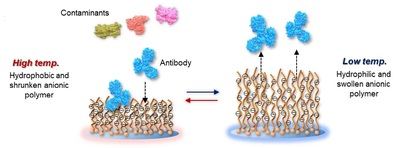Share this
Authors
Kenichi Nagase, Saki Ishii, Koji Ikeda, Sota Yamada, Daiju Ichikawa, Aya Mizutani Akimoto, Yutaka Hattori, and Hideko Kanazawa
Abstract
Antibody drugs play an important role in biopharmaceuticals, because of the specificity for target biomolecules and reduction of side effects. Thus, separation and analysis techniques for these antibody drugs have increased in importance. In the present study, we develop functional chromatography matrices for antibody drug separation and analysis. Three types of polymers, poly(N-isopropylacrylamide (NIPAAm)-co-2-acrylamido-2-methylpropanesulfonic acid (AMPS)-co-N-phenyl acrylamide (PhAAm)), P(NIPAAm-co-AMPS-co-n-butyl methacrylate (BMA)), and P(NIPAAm-co-AMPS-co-tert-butylacrylamide (tBAAm)), were modified on silica beads through atom transfer radical polymerisation. Rituximab elution profiles were observed using the prepared beads-packed column. Rituximab adsorption at high temperature and elution at low temperature from the column were observed, as a result of the temperature-modulated electrostatic and hydrophobic interactions. Using the column, rituximab purification from contaminants was performed simply by changing the temperature. Additionally, three types of antibody drugs were separated using the column through temperature-modulated hydrophobic and electrostatic interactions. These results demonstrate that the temperature-responsive column can be applied for the separation and analysis of biopharmaceuticals through a simple control of the column temperature.

Scientific Reports : https://www.nature.com/articles/s41598-020-68707-7
These Related Stories